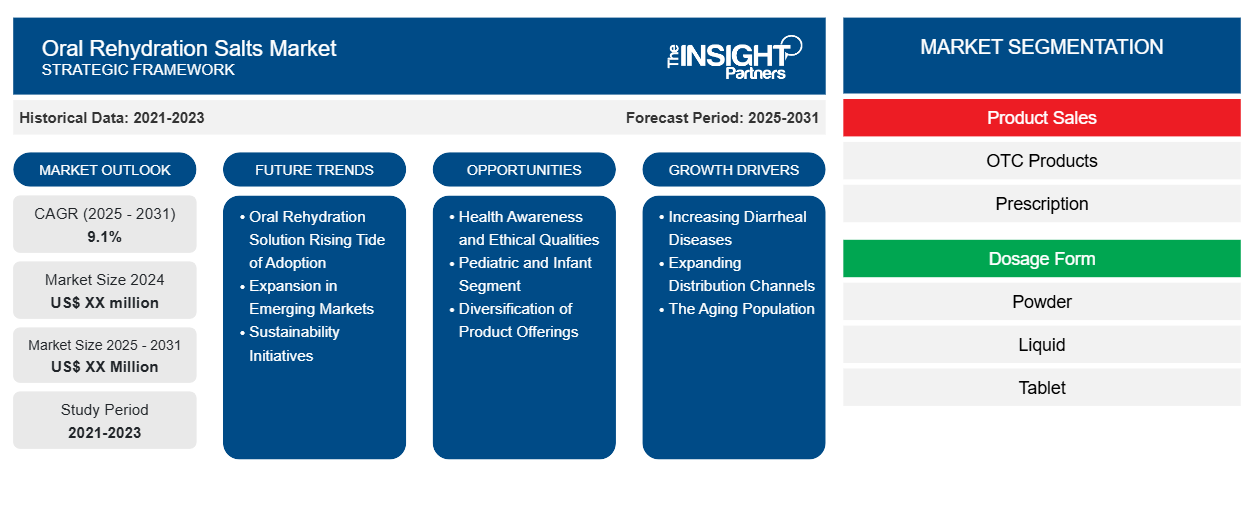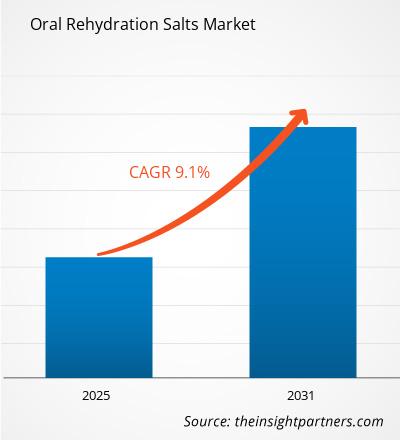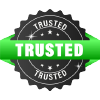The Oral Rehydration Salts Market is expected to register a CAGR of 9.1% from 2025 to 2031, with a market size expanding from US$ XX million in 2024 to US$ XX Million by 2031.
The report is segmented by Product Sales (OTC Products, Prescription). The report further presents analysis based on Dosage Form (Powder, Liquid, Tablet). The report is further segmented based on Age Group (Infants, Children, Adults). The report further presents analysis based on Indication (Gastroenteritis, Diarrhoea, Electrolyte Imbalance, Others). Futher, it is segmented based on Distribution Channel (Hospital Pharmacies, Online Pharmacies, Retail Pharmacies). The global analysis is further broken-down at regional level and major countries. The report offers the value in USD for the above analysis and segments.
Purpose of the Report
The report Oral Rehydration Salts Market by The Insight Partners aims to describe the present landscape and future growth, top driving factors, challenges, and opportunities. This will provide insights to various business stakeholders, such as:
- Technology Providers/Manufacturers: To understand the evolving market dynamics and know the potential growth opportunities, enabling them to make informed strategic decisions.
- Investors: To conduct a comprehensive trend analysis regarding the market growth rate, market financial projections, and opportunities that exist across the value chain.
- Regulatory bodies: To regulate policies and police activities in the market with the aim of minimizing abuse, preserving investor trust and confidence, and upholding the integrity and stability of the market.
Oral Rehydration Salts Market Segmentation
Product Sales
- OTC Products
- Prescription
Dosage Form
- Powder
- Liquid
- Tablet
Age Group
- Infants
- Children
- Adults
Indication
- Gastroenteritis
- Diarrhoea
- Electrolyte Imbalance
- Others
Distribution Channel
- Hospital Pharmacies
- Online Pharmacies
- Retail Pharmacies
You will get customization on any report - free of charge - including parts of this report, or country-level analysis, Excel Data pack, as well as avail great offers and discounts for start-ups & universities
Oral Rehydration Salts Market: Strategic Insights

-
Get Top Key Market Trends of this report.This FREE sample will include data analysis, ranging from market trends to estimates and forecasts.
Oral Rehydration Salts Market Growth Drivers
- Increasing Diarrheal Diseases: The increasing incidence of diarrheal diseases has sparked a major demand for oral rehydration salts in developing regions, where proper hydration is essential in avoiding dehydration and restoring electrolyte balance.
- Expanding Distribution Channels: Availability of oral rehydration salts through diverse distribution channels, like pharmacies, hospital outlets and online is expanding the market and making them available to customers.
- The Aging Population: An increasing number of elderly people are more vulnerable to dehydration due to physiological changes with aging. Therefore, an increase in the demand for oral rehydration salts as a preventive and therapeutic measure can be expected from the elderly.
Oral Rehydration Salts Market Future Trends
- Oral Rehydration Solution Rising Tide of Adoption: Oral rehydration solutions have become the new wave in this market, as they provide a more holistic approach to rehydration, by not only replacing fluid loss but also replenishing electrolytes.
- Expansion in Emerging Markets: Developing regions, such as the Asia-Pacific and Latin America, are also growing in oral rehydration salts market due to improved health awareness, better healthcare infrastructures, and rising cases of diarrheal diseases.
- Sustainability Initiatives: Sustainability packaging and production trends are under the manufacturing radar to minimize oral rehydration salts' environmental footprint because consumers are now demanding more sustainable and socially responsible products.
Oral Rehydration Salts Market Opportunities
- Health Awareness and Ethical Qualities: Spreading awareness among customers of the need for hydration and the use of oral rehydration salts helps sustain fluid and electrolyte balance is the driver for market growth.
- Pediatric and Infant Segment: Increasing demand for infant and child-specific oral rehydration salts provides a healthy market space for players, who can develop specific formulations and packaging to cater to the distinctive needs of that group.
- Diversification of Product Offerings: Manufacturers could strive to develop complementary products, for instance oral rehydration gels or powders to increase their market presence while offering more choices toward meeting dehydration-related needs.
Oral Rehydration Salts Market Regional Insights
The regional trends and factors influencing the Oral Rehydration Salts Market throughout the forecast period have been thoroughly explained by the analysts at The Insight Partners. This section also discusses Oral Rehydration Salts Market segments and geography across North America, Europe, Asia Pacific, Middle East and Africa, and South and Central America.
Oral Rehydration Salts Market Report Scope
| Report Attribute | Details |
|---|---|
| Market size in 2024 | US$ XX million |
| Market Size by 2031 | US$ XX Million |
| Global CAGR (2025 - 2031) | 9.1% |
| Historical Data | 2021-2023 |
| Forecast period | 2025-2031 |
| Segments Covered |
By Product Sales
|
| Regions and Countries Covered |
North America
|
| Market leaders and key company profiles |
|
Oral Rehydration Salts Market Players Density: Understanding Its Impact on Business Dynamics
The Oral Rehydration Salts Market is growing rapidly, driven by increasing end-user demand due to factors such as evolving consumer preferences, technological advancements, and greater awareness of the product's benefits. As demand rises, businesses are expanding their offerings, innovating to meet consumer needs, and capitalizing on emerging trends, which further fuels market growth.

- Get the Oral Rehydration Salts Market top key players overview
Key Selling Points
- Comprehensive Coverage: The report comprehensively covers the analysis of products, services, types, and end users of the Oral Rehydration Salts Market, providing a holistic landscape.
- Expert Analysis: The report is compiled based on the in-depth understanding of industry experts and analysts.
- Up-to-date Information: The report assures business relevance due to its coverage of recent information and data trends.
- Customization Options: This report can be customized to cater to specific client requirements and suit the business strategies aptly.
The research report on the Oral Rehydration Salts Market can, therefore, help spearhead the trail of decoding and understanding the industry scenario and growth prospects. Although there can be a few valid concerns, the overall benefits of this report tend to outweigh the disadvantages.
Frequently Asked Questions
Which are some of the major players operating in the market?
Which region accounted for the higesht CAGR in the oral rehydration salts market in 2023?
What are the key benefits of the oral rehydration salts market report?
What factors are driving the oral rehydration salts market growth?
1. Increasing Diarrheal Diseases.
2. Expanding Distribution Channels.
Which region dominated the oral rehydration salts market in 2023?
What is the expected CAGR of the Oral Rehydration Salts Market?
- Historical Analysis (2 Years), Base Year, Forecast (7 Years) with CAGR
- PEST and SWOT Analysis
- Market Size Value / Volume - Global, Regional, Country
- Industry and Competitive Landscape
- Excel Dataset
Recent Reports
Testimonials
Reason to Buy
- Informed Decision-Making
- Understanding Market Dynamics
- Competitive Analysis
- Identifying Emerging Markets
- Customer Insights
- Market Forecasts
- Risk Mitigation
- Boosting Operational Efficiency
- Strategic Planning
- Investment Justification
- Tracking Industry Innovations
- Aligning with Regulatory Trends





















 Get Free Sample For
Get Free Sample For